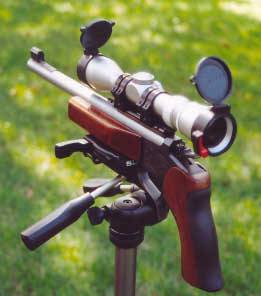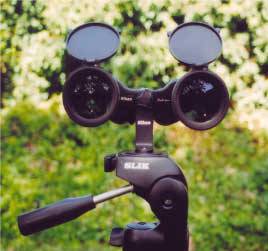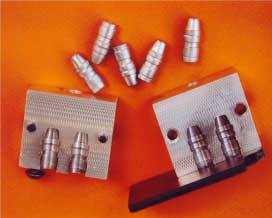You know itís really odd, but Iíve observed
that in many instances that the less expensive a scope may be, the better the
quality of the lens covers that will be furnished with it. Why is that?
For instance, just look at the scope covers found on inexpensive BSA
rifle scopes or others in that price range. Theyíre usually screw on metal caps.
Obviously they work very well to protect the lenses from dirt, moisture,
scratching, etc. At the other end of the spectrum, pricey Leupold and other
similar scopes donít provide any lens covers at all for their rifle and pistol
scopes. I donít get it.
Other brands will sometimes provide rinky dinky loose fitting see
through plastic lens caps connected with a elastic cord or something else
similar. While these arrangements are better than nothing, they leave a lot to
be desired in putting a protective seal over the exposed and somewhat fragile
lenses on our costly optical gear.
Itís the same with spotting scopes. While many spotting scopes are
equipped with tight fitting rubber caps up front, and screw on plastic caps on
the rear, Iíve seen some very expensive spotting scopes furnished with just
flimsy, press on plastic caps that can be easily flipped off with just a
vigorous shake of the scope.
Now you may be wondering why Iím making a fuss over lens covers. After
all, who cares? Well, you should.
You and I are paying serious money for our scopes. Sometimes, itís
very serious money. In return, weíre getting a very sophisticated instrument
whose lens system is coated with rare earths and other exotic materials to
optimize light transmission. Well it doesnít take much dust, dirt, smoke film,
or grit to degrade the optical performance of that expensive scope down to the
level of something costing $79.95 or there abouts. If we let that happen, we
should have just saved our money and bought something a lot less costly. The
plain truth is that good quality scope caps are necessary to keep our lenses
clean, and clean lenses mean weíll get our full moneyís worth out of our
investment.
Fortunately for rifle and pistol scopes there are a number of
aftermarket options available to to shooter. Iíve always been partial to the
products made by Butler Creek for that purpose, particularly their "Flip Open"
scope covers. They come in two varieties i.e. one that slips on a scopeís
objective lens and another that fits on the eyepiece. Both provide a waterproof,
and dust proof seal over our delicate lenses. Just push forward on a tab on the
front cover to pop up the spring loaded lid, or push down on a red lever on the
rear cover to do the same. Easy. Keep them on permanently, or if weight is an
issue for your Field Pistol or Unlimited Standing guns, just pull them off when
you shoot a match.
Itís a fine solution for rifle and pistol scopes, but what about
binoculars? If you remember, several months back I wrote about the unique
advantages of using binoculars for spotting. In a nutshell I said that
binoculars would give the spotter a three dimensional view of the target and
that would allow them to do a better job. Unfortunately, factory furnished lens
covers for binoculars fall into the same situation as those for rifle, pistol,
and spotting scopes. Some have good covers, some have lousy covers, and others
donít have any at all. As before, price - for some unknown reason, doesnít have
anything to do with whether the manufacturer will provide a decent set of lens
covers or not.
Fortunately, there is an alternative. It turns out that the Butler
Creek series of flip up scope covers will also fit over binocular lenses as
well. I canít take credit for this idea. It came from my good friend Dr. Jim
Williams who has an enthusiastic imagination and is always trying new things.
|

|
|
"Butler Creek flip
up scope covers will never get separated or lost" |
|
All you have to do to find the right size covers, is measure the
outside bell diameter of the binoculars at the objective and eyepiece ends (a
caliper is best). Take those measurements and then consult the chart found on
the Butler Creek web site. The chart will give you the inside diameter of the
scope covers in both inches and millimeters and the corresponding product model
number.
The arrangement looked so go on
Dr. Williamís binoculars, I decided to do the same on the Nikon 16X50 binoculars
that I reviewed in the IHMSA NEWS some months ago. Figuring out the right size
for the objective lens side of the binocs was easy, but the eye piece end had me
puzzled for a bit. The folding rubber eye cups were the problem. With the eye
cups unfolded out, the diameter was one thing. With the eye cups folded back,
the diameter was something larger. After a little consideration, I decided that
if I let the eye cups unfolded out to their full length, their length would
interfere with the fit of the scope cover. Consequently, I folded them back,
took my measurements accordingly, and ordered the scope covers. When I got them,
the front covers slid on without a hitch. The rear covers required a little bit
of wriggling to slide them on but the mission was accomplished with very little
effort.
|

|
|
"The scope covers give full protection to binoculars and don't
interfere with their use" |
|
I have to admit that I was very pleased with the results. I was a
little afraid that when the rear covers were in the "up" position, they might
interfere with the use of the binoculars, but that wasnít the case at all. They
worked great. I now have a pair of spotting binoculars equipped with a set of
scope covers that give max protection to the lenses, are super easy to open and
close, wonít fall off at the drop of a hat, and wonít ever get separated and
lost somewhere . (I hate it when that happens.) Now if we could only persuade
Butler Creek to make them in sizes that would fit spotting scopes as well. If
you want the max in protection and convenience for your rifle and pistol scopes,
and binocs, try a set of the Butler Creek lens covers.
Forend Stabilizer - Testing loads and shooting groups with a TC is tough. Itís a demanding
task that requires a lot of concentration and rock solid support. After all,
weíre trying to determine the level of performance of the gun and load and at
the same time trying to eliminate the shooters skill or lack of skill as a
factor. In other words, were trying to evaluate the gun and load and not the
shooter.
When reviewing a particular cartridge in a
TC, or a custom TC barrel, Iíll build a stack of sand bags and jam the gun into
the bags with moderate pressure while making sure the bottom of the grip is well
supported by another bag underneath.
Fortunately the bottom the TC grip is flat, so that helps somewhat to control
side to side rocking motions. Helps - not eliminate. The real problem is the
thin, rounded TC forend which almost seems to have been deliberately designed
induce side to side instability into the gun. Yes, there are some TC forends out
there that are flat on the bottom, but theyíre so narrow that their ability to
prevent these unwanted motions is practically nil.
Whatís really needed is a wide, flat forend such as is available from
the custom TC barrel makers. Such forends, which are often 2.5-3" wide and can
be as long as the whole barrel, effectively eliminate all side to side rocking
motions and allow you to shoot the best groups the gun and the load are capable
of producing. Unfortunately, many of the custom TC barrel makers make these
forends to fit only their own unique hanger bar mounting system and not on the
standard set up that the TC factory uses.
There is an alternative however, and thatís the
Possum Hollow Forend Stabilizer that is sold by Sinclair International. This is
a piece of black, UHMW plastic molding that measures three inches wide and four inches long.
Additionally, there are two "ears" measuring 2" high on either side of the plate
on which two 1.25" long rubber tipped delrin screws are horizontally mounted .
The basic idea behind the stabilizer is that it provides a very stable
platform that the average sporting rifle shooter could attach to their gun when
working up loads for the hunting season. The stabilizer is mounted by simply
removing the swivel sling stud that most hunting rifles are equipped with, and
using a furnished screw to attach the stabilizer to the stock. When the hunter
has developed their loads, the stabilizer is just as easily removed.
It struck me that such a system would be be just as useful to use when
testing a standard 14" TC barrel. There is a small obstacle however. TC forends
for 14 " barrels donít have sling studs. No stud, no hole that we can use to
mount the stabilizer. You would think that TC would offer such a forend since
14" barrels are supposed to be used for hunting as well as target work, but ....
Not to worry. Since weíre talking about unlimited guns, I donít see
any reason you couldnít just drill a mounting hole into your existing TC forend.
If youíd rather not do that, there are plenty of used TC forends floating around
for sale at gun shows, etc. that you can pick up to mount the stabilizer on just
to check loads.
After you have the stabilizer securely mounted on your TCís forend,
just twist in the two side screws to the point where the rubber tips are firmly
pressing against the sides of the forend. Donít over do it as you can buckle the
screws. The screws are there just to provide some additional side support to the
stabilizer. Now youíre ready to go.
Now to be perfectly honest, because most TC forends are angled from
the rear to to front, the attached stabilizer will be sloped at the same angle
as well. Consequently, if you rest the forend on a hard, flat surface like a
benchrest without a bag, you wonít have advantage of the full 12 square inches
of footprint that the stabilizer provides. However, if you shoot off sand bags
as I do, the bags can be arraigned to compensate for this situation.
The stabilizer is very effective in preventing side to side wiggles,
so all you have to do is concentrate on the vertical movements. This is a very
simple and robust piece of gear that anyone who tests loads in a TC or in a
rifle can use. Itís not expensive either. Just call Sinclair at 260-493-1858 and
theyíll sell you one for only $18.25. Also check out their web site at
or
call their tech line at 913-362-9455.
By the way, if youíre really interested in reloading for the 50 S&W,
check out Leadheads new 465 grain gas checked cast bullet. It looks like a
perfect match. Say what you will about this cartridge, itís not boring.
NEI Bullet Molds - I learned just recently that Walt Melander, owner & operator of NEI,
has passed away. Walt and NEI were definitely one of the major players in the
world of cast bullet shooting. There was no one that had such an huge selection
of bullet molds to choose from. It must have been hundreds of designs.
|

|
|
"NEI aluminum molds are high quality products that are very easy
to use |
|
Walt always worked hard to maintain a personal touch. Whenever, I
would do a review of one of his excellent aluminum molds, Iíd always get a very
nice letter from Walt commenting on the article. He was a real gentleman in the
best sense of the word whom I always enjoyed chatting with. The knowledge that
man had about cast bullets and mold making will be sorely missed.
It looked for a while that with Waltís passing, that NEI might leave
the scene as well. However, Waltís daughter Patty has got the business up and
running again in a new location in El Paso, Texas. The full catalog is there and
they are offering the whole line up of products and services just as before. By
the way, although NEI has always been known for their top quality aluminum
molds, they offer the same designs in iron as well.
If you are looking for something different, visit NEI at
![]()